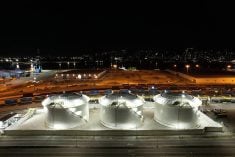OLDS, Alta. – Cattle producers may soon be able to select cattle that
eat less feed without affecting growth or productivity.
For rancher Doug Havens of Madden, Alta., it’s research he can use.
“When hay is 12 cents a pound, that’s when you start thinking
efficiency,” Havens said after a presentation about the feed efficiency
trial at Olds College.
Now, when Havens buys a bull, the only clue to its efficiency is a
Record of Performance test number that measures the animal’s rate of
Read Also

Canola oil transloading facility opens
DP World just opened its new canola oil transload facility at the Port of Vancouver. It can ship one million tonnes of the commodity per year.
gain. An ROP number doesn’t tell the producer which animal eats the
least and gains the most in a herd.
“I’m glad to see you’re doing this efficiency thing. It’s long
overdue,” said Havens, who believes a net efficiency number would help
him select animals that can save him money, especially when buying
animals at a bull sale. Net feed efficiency is moderately heritable.
In an earlier net feed efficiency trial, the most efficient steer ate
$45.69 less feed over a 120-day trial than the least efficient steer,
said Pat Ramsey, a beef specialist with Alberta Agriculture.
“We think it’s got fairly significant potential to improve the
profitability in the beef industry,” Ramsey said.
Net feed efficiency is the difference between an animal’s actual feed
intake and its expected feed requirements for maintenance and growth.
If the animal eats less than expected, it is a more efficient animal.
For example, if a steer averaged 1,000 lb. body weight over the last
120 days on feed and its average daily gain was 3.9 pounds per day, the
prediction would be the animal would eat 32 lb. per day over that
period. If the actual feed intake was 22 lb. per day, this would be 10
lb. per day less feed than expected and its net efficiency intake would
be Ð 10 lb. per day. Like a golf score, a negative number indicates a
more efficient animal.
“It’s possible to reduce feed intake without compromising performance,”
said Ramsey.
New technology has allowed researchers to measure the individual net
feed intake of each animal while the animals are still in a group.
Using a new weigh scale and computer software called GrowSafe,
researchers can monitor what each animal eats during the feeding trial.
Before, scientists would have to keep each animal in separate pens and
weigh the amount of feed put into the feed bunk and what was left over
to find out how much each animal ate. It was labour intensive and
inaccurate.
With the new system, an electronic ear tag sends detailed feeding
information back to a computer in a room at the college. The feed
trough is like a large tub on a weigh scale that measures how much feed
is in the bunk. Each time the animal puts its head through the head
gate to eat, a computer program measures how much the animal is eating,
how much time it spends at the feed bunk, if it pushes hard down into
the feed or if it nibbles at the feed.
John Basarab, a research scientist at Lacombe, Alta., said the new
feeding system has already dispelled the myth that cattle eat the same
amount each day.
Little bars on the computer screen show when and how much each animal
eats. A closer look at one animal showed a dramatic drop in feed intake
one day. Researchers know that was a snowy day when the cattle were
huddled against the windbreak for shelter and not spending time at the
feed bunk.
Another day, Ramsey dialed into the computer from his home in High
River, Alta., and noticed an animal wasn’t eating. He phoned the
college and asked the staff to check it out. They found that a Horned
Hereford bull was having trouble getting its horns through the narrow
head gate. The bull was eating but he’d learned to turn his head
sideways to eat and the ear with the electronic ear tag was outside the
head gate. The head gates were modified.
The computer has also proven its worth as an early detection system for
sick cattle. By watching feed intake researchers can usually spot sick
animals three or four days sooner than a pen checker walking through
the animals.
“This system can pick them earlier and more often,” Basarab said. “This
is a tool to allow us to see things we’ve never seen before.”
















